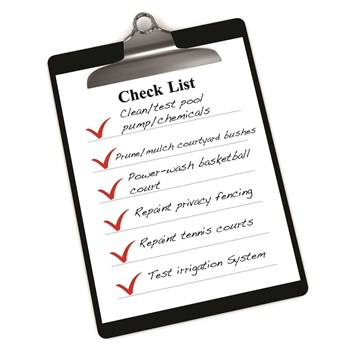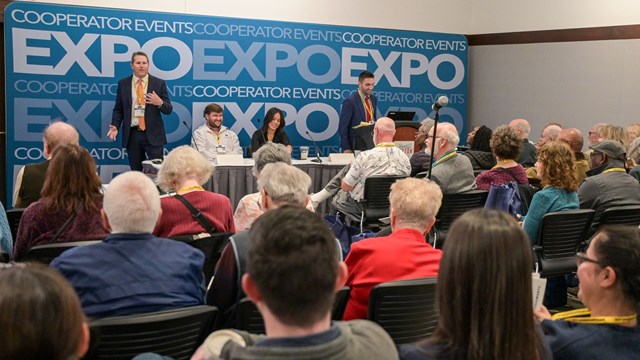
The winter of 2015 certainly was one for the record books. From epic amounts of snow to the never-ending plowing and clearing of the pesky white stuff, the first few months presented many weather-related challenges for New England’s condominium communities.
In addition to dealing with ice damage to their properties, communities in this region also have to contend with destruction from periodic hurricanes, cleaning up fallen leaves, and ongoing tree trimming. There’s always lots to be done around any condominium—especially during the spring.
Now is the ideal time to head outdoors and check your property’s amenities from playgrounds and pools to tennis and basketball courts. Here’s a look at the numerous tasks associations need to tackle before the exterior amenities can open for business.
Grab the Clipboard & Take a Walk
“The spring walk-through is a must for assessing the current condition of existing amenities,” said Meghan O’Brien Taylor, president of M.E. O’Brien & Sons of Medfield, Massachusetts, which provides and maintains site furnishings—including fencing, playground equipment and benches. “As soon as the snow melts, get outside and evaluate what the heavy snows and ice may have damaged. Plowing can do a real number on outdoor amenities at condo complexes. Snow plows pushed snow back further and further and may have disturbed or even moved playground equipment and benches.”
The initial spring walk-through is best done between March 1 and April 15—or whenever the snow melts, offers David J. Levy, CMCA, PCAM, president of Sterling Services in Holliston, Massachusetts, which manages 32 condominium properties. “Make sure every asset is safe to use.”
“If you do a thorough inspection of every piece of playground equipment and inventory it in the spring, you will be cognizant of what you have,” Taylor adds. It’s good to repeat the walk-through every few weeks during the season. Throughout the year, the owner or property manager should inspect the amenities, too.
And don’t limit your inspection to the equipment: check the playground surfacing. “Visually inspect the surfacing whether it is unitary or loose fill,” Taylor said. “A unitary surface such as locking rubber safety tiles does not move, but it can crack. Loose fill, which is composed of wood chips, will need to be topped off every two to three years. An indicator strip will point out when the fill needs to be replenished to a certain depth. The contractor has done a good job if you do not see the indicator strips since they should be hidden under the fill. A reputable company will provide a maintenance kit containing instructions on how to care for the surface.”
To ensure the surfacing is suitable, walk the playground and sport courts to see if something is broken or vandalized. “While you are walking it, touch it,” she recommends. “Look for glass and other foreign objects on the surface.”
When it comes to graffiti, Taylor says remove it immediately. “Graffiti attracts graffiti. Get rid of it. Show that it is unacceptable,” she said. Newer materials and less surface area on new play equipment make recently added playgrounds far more graffiti-resistant than older areas, which helps lower maintenance costs, she adds.
Also, cut back tree branches so that they are no closer than seven feet from the playground, she suggests.
Craig Swain, president of New England Sealcoating Co., Inc., agrees. “We recommend trimming trees back so mold does not grow in the shaded areas on a playground or court surface. Also, if you rake and remove the leaves in the fall and then pressure wash the courts during the busy season, that prevents mold from growing and damaging the surface,” Swain says.
Tennis, Anyone? Caring for Those Courts
Once a desirable amenity for a condo owner, tennis courts at complexes nowadays are often underused, unused, or even repurposed. “Tennis is less popular than it was in the 1970s and 1980s,” says Levy, “so properties with two courts, for example, might keep one tennis court and convert the other into a basketball court and/or a children’s play area.”
Of course, whether the courts are used for tennis, basketball, or kids’ play, they do need attention before they open usually around the beginning of May and will require periodic maintenance throughout the year. Sun, rain, snow, freezing and thawing cycles and ongoing use all take their toll on the courts, which must be closely inspected for surface cracks, trip hazards caused by frost heaves, and fence damage.
Make sure net posts are secure, too. Swain suggests a bell-shaped, net-post foundation because it is harder for the frost to push the foundation up. “Typically, it is the moisture in the ground and the frost pushing the foundation upward that causes problems,” he adds.
Repairing surface cracks must be at the top of the maintenance to-do list. Swain recommends a membrane system, such as ARMOR® or RITEWAY®, to fill and repair cracks. “You will get a number of years out of this repair provided the court does not have moisture issues. Both are water-tight products,” he adds.
Alternatively, a quick fix for cracks are materials mixed with concrete and acrylic crack fillers. “These are inexpensive, but not very flexible,” he warns. “They look great at first and tend to fail during the first or second winter.”
Another option is applying hot-rubberized asphalt, which will keep the crack sealed shut because of its flexible material. “However, it is hard to be applied flush with the court and the color coating tends to wear off of it because of its flexibility,” Swain explains.
If the court needs color coating, which like crack sealing is a weather-sensitive application, it requires at least 24 hours of drying time. The basic formula consists of three coats: an acrylic resurfacer plus two coats of the finish. “An extra coat of resurfacer for a total of four coats will make the surface look fantastic,” he adds.
The average lifespan of the color coating varies. “Everyone’s court is a little different,” says Swain. “The amount of play a court gets is a major factor and how much the appearance matters. Most courts are redone every five to eight years. If the court has cracks, we recommend having it inspected every two to three years to keep up with maintenance.”
What’s New with Amenities?
In the playground world, more durable materials are on the upswing, Taylor says. “No longer post-and-deck structures, but moving features—especially a Vortex Splashpad®. Communities now add them to their pools, place them adjacent to the pool, or include it instead of a pool. There’s a demand for creating an aquatic center.”
Taylor says condo associations are upgrading amenities because the economy is getting stronger. “I’ve absolutely seen an increase in spending money on amenities,” she points out. “We had a rough four to five years of tightening the purse strings but people are spending again. There’s a shift when the market is improving. How can my area look better? How can I have that ‘wow’ factor? Put in a better play area, for example.”
Levy, however, notes that children are not playing outside as much and therefore are not using playgrounds like they once did. “What we are seeing in our properties is an increase in dog- friendly stations that provide mutt mittens to scoop up and dispose of pet waste. There are less children and more dogs living in many of these complexes,” he says.
Lowering Higher Energy Costs
One thing is certain: Condo associations are always looking for ways to trim energy costs, especially when it involves operating and maintaining a pool.
“Many properties are still economically-challenged because of the recession,” says Levy. “They will opt to open the pool on Father’s Day instead of Memorial Day, the typical opening day. It will remain open until Labor Day, especially if it is a kid-based property. The community saves two weeks on pool-operating costs with a delayed opening.”
Some properties use a solar-heating solution for their pool. “They can open April 15 and close October 15,” he says. “People do not go in the pool because the water is too cold. Solar can warm the water for a longer swimming season.”
Going green is woven into more conversations nowadays with condo associations. “The cost of electricity is going up—it is on their minds,” Levy adds. “Clients want solar-automated pool covers. Heating a pool via a solar application is a great alternative because the systems are simple and relatively inexpensive.”
Swimming Pool Safety
A swimming pool is considered a must-have amenity for many condominium properties, but it does embody many safety concerns. Certainly hire a certified pool operator to effectively, efficiently and safely run the pool and facility, but what are other necessary actions to take?
In December 2007, a major law was passed to ensure the health and safety of anyone using a public or commercial swimming pool or spa. The Virginia Graeme Baker Pool and Spa Safety Act (VGBA), also known as the Pool & Spa Safety Act (P&SSA), was designed to prevent injuries and fatalities caused by swimmers and soakers being trapped by the suction of underwater drains. Under the law, all public pools and spas must have ASME/ANSI A112.19.8-2007compliant drain covers installed and a second anti-entrapment system installed, when there is a single main drain other than an unblockable drain.
Every pool and spa drain cover available for sale in the last five years has complied with the VGBA, according to Thomas M. Lachocki, Ph.D., CEO of the non-profit National Swimming Pool Foundation (NSPF) in Colorado Springs, Colorado.
“Therefore, facilities who changed their covers are most likely partly in compliance,” he stresses. “Facilities with a single main drain also must put in a second level of protection. If you have not changed drain covers in the last five years, the odds are good that you are not compliant.” If you do not have dual main drains separated by three feet with certified covers, Lachocki suggests taking the free Pool & Spa Safety course available from NSPF (www.nspf.org) to understand the law and bring your pool into compliance.
If your condominium does not have a Certified Pool/Spa Operator® on staff or servicing your pool, train them now, Lachocki emphasizes. There are more than 1,000 CPO certification courses listed online at www.nspf.org. The most common and widely accepted by health departments is the Certified Pool/Spa Operator® Certification course.
Also, The Centers for Disease Control & Prevention (www.cdc.gov) issued the Model Aquatic Health Code (MAHC) in 2014. This voluntary guidance document, based on science and best practices, helps local and state authorities make swimming and other water activities healthier and safer. States and localities can use the MAHC to create or update existing pool codes to reduce risk for outbreaks, drowning, and pool-chemical injuries. The MAHC guidelines address the design, construction, operation, maintenance, policies, and management of public aquatic facilities.
“It is important that the people who operate or service your pool review the MAHC and guide your condo association on future facility investments to help keep the pool safer,” Lachocki says.
The Off Season To-Do List
Since spring heralds the outdoor exodus to embrace the warmer weather, what activities can condo associations focus on during the fall and winter seasons to get ramped up amenity-wise for this busy season?
Winter is a great time to research and select playground equipment and passive amenities such as benches, Taylor says. “Condo associations are educated buyers because of increased mobility. People have seen what they want and come into our showroom and may have already made up their minds. They want their facility to be as desirable as possible should they want to sell. The winter is ideal for coming into our showroom to see the latest trends,” she adds.
If your association wants to add new equipment, “don’t procrastinate,” Taylor emphasizes. “Set a realistic deadline. Construction takes time and you do not want to be scrambling to get something installed. Six to eight weeks is normal from the time the manufacturing order is placed to when the playground is installed. If we’ve had a long winter like the one we just had, people are anxious to get outside as early as possible.”
Go back out and tour the complex in the fall with your trustees, Levy advises, to determine what needs to be fixed or replaced so these funds can be budgeted. This is an ideal time to contact potential vendors and negotiate maintenance contracts.
Since spring is the busiest time of year for prepping outdoor amenities in News England for condo associations and contractors, “do as much prior proper planning beforehand,” he adds. “You’ll have fewer surprises to deal with in the long run. But after this past winter, snow budgets exhausted the reserves a condo community may have. How will we replenish those reserves will be the conversation now instead of what amenities to add,” Levy says.
Cynthia Allegrezza is a freelance writer in Massachusetts.






Leave a Comment